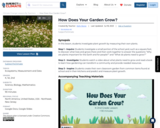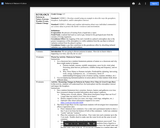
SYNOPSIS: In this lesson, students investigate plant growth by measuring their own plants.
SCIENTIST NOTES: This lesson lets students discover the importance of plants in their environment and the basic materials plants need for growth. It also contains an activity for students to measure plant growth rate so as to discuss the factors that influence plant growth. All the accompanying materials in the lesson are well-sourced, and this lesson has passed our science credibility review.
POSITIVES:
-This lesson includes elements of project-based learning through hands-on activities.
-This lesson is cross curricular.
-The materials are easily accessible for teachers and can be collected by students from home. Consumable items can be collected from home, donated by families, or even local companies that support education. If donations are not possible, seed and bean costs are minimal and can be shared among multiple teachers in a school.
-Parts of the lesson can be conducted outdoors to connect with nature.
ADDITIONAL PREREQUISITES:
-For the Inquire section, students need access to outdoor space with living things to observe.
-The lesson time is approximately 90 minutes, but the lesson also requires ~10 minutes daily for 2 weeks after the lesson to measure and log plant growth in their journals.
-Students should have a basic understanding of the difference between living and nonliving things.
-Students should have an understanding of what living things need to grow.
DIFFERENTIATION:
-This lesson can be taught as three separate ~30 minute lessons.
-Students can graph growth at the end of the 2-week time period showing how their plants changed. This is an assessment opportunity for teachers to determine understanding of measurement.
-If there is no possibility of a nature walk or finding space outside for observation, substitutions can be made such as observing a living plant in a pot, a photograph of a space outside, a raised garden bed, etc.
-Due to the hands-on aspects of this lesson, English language learners can engage and be supported with vocabulary in their native language.
-The Plant Growth Journal can be edited to include additional writing opportunities.
-Measurements can be made through standard or nonstandard units of measure.
-Graphing can be included for students ready to engage in graphing based on grade level.
-Enrichment lessons can be included through designing outdoor space at students' homes or creating a school garden.
- Subject:
- Biology
- Life Science
- Mathematics
- Material Type:
- Lesson Plan
- Provider:
- SubjectToClimate
- Author:
- Kelly Stone
- Date Added:
- 06/30/2023


